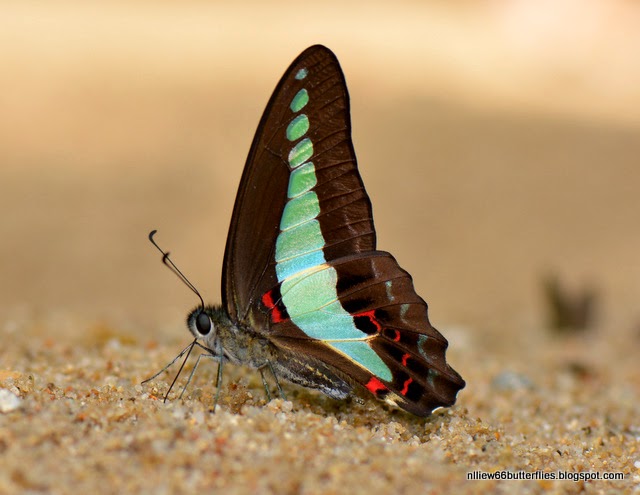Common throughout the year and unmistakable - the black wings have a series of translucent blue spots along the median of the FW and HW with some red spots on the marginal area of the HW underside. They can be observed on the wings on all localities, including flowering bushes along roadsides and wasteland in Raub. They are more likely to be encountered as mass puddlers in forested hills where open seepages and river sandbanks are tainted with animal urine or faeces.
Habitat indicator
RSP
|
WV
|
PG
|
VF
|
FTR
|
SC
|
LWDF
|
LWPF
|
LMEF
|
UMN
|
MN
|
x
|
x
|
x
|
x
|
x
|
x
|
x
|
x
|
x
|
Frequency observation chart: (S marks the usual occurences, H marks an unusually high occurence, F for first record)
2013
| |||||||
Mac
|
Apr
|
May
|
Jun
|
Jul
|
Aug
|
Sep
|
Oct
|
H
|
S
|
S
|
S
|
S
|
S
|
S
| |
2013
|
2014
| ||||||||||
Nov
|
Dec
|
Jan
|
Feb
|
Mac
|
Apr
|
May
|
Jun
|
Jul
|
Aug
|
Sep
|
Oct
|
S
| S | S | S | S | H | S | S | S | S | S | S |
2014
|
2015
|
||||||||||||
Nov
|
Dec
|
Jan
|
Feb
|
Mac
|
Apr
|
May
|
June
|
Jul
|
Aug
|
Sep
|
Oct
|
Nov
|
Dec
|
S
|
S
|
S
|
S
|
S
|
S1(H)
|
S1(H)
|
S
|
S
|
S
|
S
|
S
|
S
|
|
2016
|
|||||||||||
Jan
|
Feb
|
Mac
|
Apr
|
May
|
Jun
|
Jul
|
Aug
|
Sep
|
Oct
|
Nov
|
Dec
|
S
|
S
|
S
|
S1(H)
|
S1(H)
|
S1(H)S2S6
|
S
|
S
|
S
|
S
|
S
|
S
|
2017
|
|||||||||||
Jan
|
Feb
|
Mac
|
Apr
|
May
|
Jun
|
Jul
|
Aug
|
Sep
|
Oct
|
Nov
|
Dec
|
S
|
S
|
S
|
S1(H)
|
S1(H)
|
S1
|
S1
|
S1S2
|
S1S2
|
S1(H)
|
||
2018
|
|||||||||||
Jan
|
Feb
|
Mac
|
Apr
|
May
|
Jun
|
Jul
|
Aug
|
Sep
|
Oct
|
Nov
|
Dec
|
S
|
S
|
S
|
S
|
S
|
S
|
S
|
|||||
|
2019
|
|||||||||||
|
Jan
|
Feb
|
Mac
|
Apr
|
May
|
Jun
|
Jul
|
Aug
|
Sep
|
Oct
|
Nov
|
Dec
|
|
S
|
S
|
|
|
|
|
|
|
|
|
|
|
|
2020
|
|||||||||||
|
Jan
|
Feb
|
Mac
|
Apr
|
May
|
Jun
|
Jul
|
Aug
|
Sep
|
Oct
|
Nov
|
Dec
|
|
|
|
|
|
|
|
|
|
|
|
|
|
The Common Bluebottle is perhaps the most common Graphium species encountered in a forested area. It can be seen flying swiftly once the sun has warmed up the forest path along cleared areas on the forest's edge and as the sun hits the zenith, be seen puddling on a moist spot. Despite that it can puddle en masse, a slight disturbance will be enough to send the whole patch scuttling in all directions (if you're close enough when they take flight, you can hear buzzing sounds created by their rapid wing flappings almost like a Hummingbird). These few examples are taken from end of March till April where they are exceptionally abundant in certain areas...almost all taken at around noon.
An intense number of single species puddling on a moist sand patch.
The remaining group as the rest flew off on being approached...
Above two photos taken on 29 May 2013 @ 14:43
Above two photos taken on 29 May 2013 @ 14:43
At an angle against the morning sun, the wings seem lighted up like a lantern due to its translucent blue spots. 19 December 2013 @ 11:51
Victim of a road accident: this one was struck by passing motorbikes but still conscious. 13 April 2014 @ 10:34. Note the beautiful translucent blue of the newly eclosed specimen.
Mass congregation on sunny moist spots - 13 April 2014 @ 12:59
Victim of a road accident: this one was struck by passing motorbikes but still conscious. 13 April 2014 @ 10:34. Note the beautiful translucent blue of the newly eclosed specimen.
Mass congregation on sunny moist spots - 13 April 2014 @ 12:59
02 Dec 2104 @ 12:28
05 Dec 2014 @ 12:07
07 Dec 2014 @ 12;42
Against the light: 7 Dec 2014 @ 13:13
15 Mac 2015 @ 13:26
sunning itself: 14 June 2015 @ 14:30
15 June 2015 @ 13:04
16 June 2015 @ 14:46
Visiting flowers at over 1000M: 05 Dec 2015 @ 11:55
23 Apr 2016 @ 11:55
22 June 2016 @ 12:14
18 Mac 2017 @ 13:20
14:18
14:21
Above pictures 08 April 2017
This year, their abundance was exceptional and prolonged possibly due to the unusually wet weathers throughout April and May - effects from climate change? 27 May 2017 @ 11:55
05 Dec 2014 @ 12:07
07 Dec 2014 @ 12;42
Against the light: 7 Dec 2014 @ 13:13
15 Mac 2015 @ 13:26
sunning itself: 14 June 2015 @ 14:30
15 June 2015 @ 13:04
16 June 2015 @ 14:46
Visiting flowers at over 1000M: 05 Dec 2015 @ 11:55
23 Apr 2016 @ 11:55
22 June 2016 @ 12:14
18 Mac 2017 @ 13:20
14:18
14:21
Above pictures 08 April 2017
This year, their abundance was exceptional and prolonged possibly due to the unusually wet weathers throughout April and May - effects from climate change? 27 May 2017 @ 11:55
























